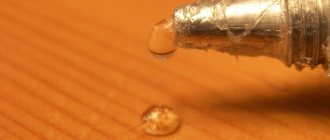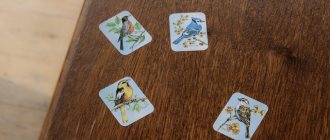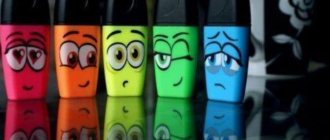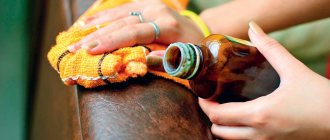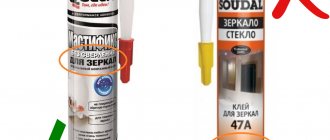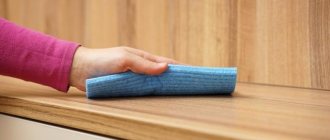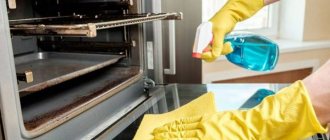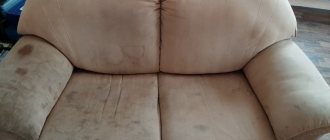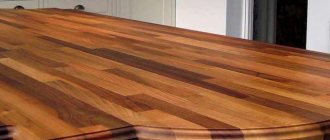Manufacturers are required to stick labels on their products so that potential buyers can familiarize themselves with information that may concern them. However, in most cases, labels are also perceived as an ugly sticker that spoils the appearance of the product. Therefore, many new product owners try to remove it as soon as possible. And then the question arises before them: how to remove the glue from the sticker from the plastic.
- How to remove glue from a sticker
- Special products for removing glue from stickers
- We show marks on clothes
- Removing stains from furniture
- From glass and ceramics
- Cleaning plastic
- Other surfaces
- Traditional methods for removing traces of stickers and tape
- Heat treatment with a hairdryer
- Using alcohol or acetone
- Distilled vinegar
- Masking tape
- Using sunflower oil
- Eraser
- Wet wipes
- Microfiber sponge
- Refined gasoline
- Lemon or citric acid
- Take precautions
- Finally
It is not always possible to defeat sticker glue using standard methods. The label itself is quite difficult to peel off so carefully that the adhesive substance does not remain on the surface of the product. If you don’t get rid of the glue right away, dirt will soon stick to it, which will be much more difficult to remove.
In this article we will look at the pressing question of how to remove sticker adhesive from different surfaces. Let's look at the most popular methods for removing label residues, traces of tape and other labels.
Is it possible to remove the adhesive from a sticker?
For marking, a weak adhesive composition is used, which can be removed with improvised means. If you remove a sticker, immediately clean the surface of the adhesive, otherwise dust and dirt will stick to it.
But if you can’t remove the entire label, use these recommendations:
- Do not scrub the glue with cold water, otherwise it will harden.
- Use lint-free or cotton rags rather than cotton pads.
- Test the product on a small area so as not to damage the surface.
- Remove the sticker from clothing and textiles slowly to avoid damaging them.
Remove stickers immediately before the glue sets into the surface.
Necessary Preface
There are several conditions that, if met, will allow you to quickly and effectively remove glue stains.
- Don't delay cleaning. If you remove a sticker that leaves a sticky mark, remove it immediately. Otherwise, the remaining glue will attract dirt, dust, and hairs, and if the sticker was on an enamel pan, then after the first use the fire will “impress” the dirt into the base, and it will be much more difficult to wash the sticker off such dishes.
- Meanwhile, moderate heat is a good assistant in cleaning. You can use a hair dryer. The softened adhesive trace can be easily wiped off with a napkin.
- When choosing a chemical, first check its effect on an inconspicuous area, and only then treat the entire desired surface.
Types of stickers
Stickers come in paper and polymer types; they need to be removed in different ways.
Paper based
To remove the paper sticker, simply moisten it with warm water. After 3–5 minutes, wipe the soaked base with a sponge and remove any remaining glue using washing powder.
To remove a laminated sticker, remove the film, then wet the label with water.
Polymer based
A polymer sticker is more elastic than paper and melts at high temperatures. To remove the sticker, you need to peel off the transparent film and remove traces of glue using dishwashing detergent. If the label is difficult to remove, heat it with a hot hairdryer.
Mechanical cleaning by hand
Manual cleaning is most often used either due to the lack of special detergents and compounds, or when it is impossible to use chemical cleaners.
Also a major factor for using manual cleaning is the risk of surface damage.
To manually remove stickers, you can use any of the available means - napkins, dish sponges. During such cleaning, you should carefully monitor the degree of impact on the surface being cleaned, avoiding excessive zeal, in which case you will be able to achieve the best result.
Regardless of whether any specific product is used to remove stickers and adhesive residues, or whether manual cleaning is performed, following the tips offered in this material, you can achieve the main thing - permanently peel off the sticker without leaving a trace.
Now you know everything about removing sticky residue from stickers.
Methods for removing glue from a sticker
Try simple methods first. If glue remains, use chemicals or special products.
Hairdryer
Using a hairdryer you can remove even old glue stains. Set the temperature to maximum, heat the surface and carefully remove the adhesive with a plastic spatula, an old credit card or the back of a knife. If small particles of glue remain, treat the area with soapy water or vegetable oil.
Do not use a hair dryer on painted or plastic surfaces: high temperatures may cause the paint to swell and the plastic to deform.
Alcohol or acetone
The method is suitable for glass, metal surfaces and tiles. Dampen a rag with alcohol or acetone, apply it to the stain and after five minutes remove traces of glue with a soft sponge. To get rid of a specific odor, wash the dishes with soap or a special product.
Distilled vinegar
Soak a rag in white vinegar and apply it to the glue stain. After 10 minutes, remove the soaked glue residue with a plastic card and wipe the surface with a soft, damp cloth, and then with a dry one. It is better not to use this method on plastic.
Masking tape
You can remove fresh glue from the label using a paint tool.
tape or tape - this method will not harm the surface. Stick it on the stain and tear it off sharply. Repeat the procedure several times.
Sunflower oil
Any oil will do: the fat will dissolve the adhesive. Apply the liquid to the surface or cover the glue marks with an oil-soaked cloth and wait a few minutes. Then peel off the paper and remove the softened particles with a damp cloth.
Eraser
The eraser is great for removing fresh sticker marks from hard surfaces. Dampen the stain, wipe with a dry cloth and honeycomb
Rub away the glue with an eraser. If it doesn't work the first time, repeat the procedure.
Wet wipes
Wipes soaked in alcohol will do. If the stain is dry, first moisten it with water and then wipe it dry. Using a napkin, remove any remaining adhesive from the surface and rinse the surface.
Petrol
This method is good at removing glue stains on glass and metal. It is better to use purified household gasoline rather than automobile gasoline. Moisten a napkin with liquid and wet the stain. Wait until the glue softens and wipe off the dirty area.
Lemon acid
To prepare the solution, mix two tablespoons of powder and 100 ml of warm water. Dampen a soft cloth in this solution, blot the dirt and leave for 15 minutes. Then wipe the surface with a clean damp cloth.
Special cleaning products
If household methods do not help or you don’t want to waste time preparing solutions, try professional remedies. They are universal, you can choose the right one for any surface.
Three effective remedies:
- Liqui Moly Cleaner. This is a car body cleaning spray that can be used at home: it quickly removes stickers from any surface. Spray the product onto the stain and leave for five minutes. Then wipe with a damp sponge and dry cloth.
- Universal aerosol "Antiscotch". Suitable for paints, glass, stone and metal. To remove dirt, spray the product onto the stain, leave it for 3-5 minutes and clean off any remaining adhesive with a sponge or napkin.
- Prosept Cleaner. Will clean any surfaces resistant to organic materials from traces of stickers and tape in 2-3 minutes. Treat the stain with the concentrate, leave for a few minutes and wipe with a damp cloth. Please note: has a slight whitening effect.
Professional products
Modern preparations sold in retail outlets will help you get rid of traces of glue quickly and without consequences. The most popular of them:
- Scotch Remover. Removing traces of tape and labels is the main purpose of this product. It contains active citrus oils, which help dissolve stains from stickers, tar, resin and self-adhesive films.
- Liqui Moly. A universal sticker cleaner will help you completely remove marks from glass, metal and resistant plastic. Consists of natural ingredients.
- ASTROhim. The product contains a complex of special additives that penetrates deep into the dirt, after which it softens and partially breaks down. Quickly removes stubborn adhesive stains and traces of bitumen, while being safe for the surface being treated.
- Profoam 2000. Broad-spectrum cleaner. Suitable for processing any coating, odorless, removes traces of glue, labels, markers, oil and many other contaminants.
- Fine Glass. The main purpose is glass cleaning. In addition, the mixture completely washes away adhesive traces on dishes, ceramic surfaces, metal and most types of plastic.
How to properly remove sticker adhesive from different surfaces
When choosing an adhesive remover, consider the type of material.
Automobile
To avoid scratching the paint, do not use scrapers, aggressive chemicals or abrasives. A special car wash product or soap solution will help get rid of glue stains: apply the product to a soft sponge and carefully wipe the sticker mark. Refined gasoline effectively fights glue: soak a microfiber cloth in it and treat the stain.
Dishes
The easiest way to remove traces of glue from new dishes is to treat them with lemon. Rub the stain with a lemon wedge and then with a damp sponge. To remove old stains, use
for nail polish remover. Soak a rag in the solution, wipe off the sticker, and then rinse the dishes under hot water and dishwashing detergent.
Banks
To remove label marks from a glass jar, fill it with hot water and let sit for 30 minutes. When the glue softens, wipe it with a soft sponge. To prevent jars from bursting, avoid sudden temperature changes.
Another way to get rid of glue: mix baking soda with water at room temperature in a 1:2 ratio. Soak a sponge in the solution and remove the dirt.
Fridge
Apply vegetable oil to the stain, leave for 20 minutes and wipe with a damp cloth. You can use kerosene, acetone or alcohol: soak a rag in the liquid and treat the surface.
Old stains can be removed with a hair dryer. Warm them up with hot air and gently scrape them with a plastic card.
Laptop
Dampen a microfiber cloth with water and wipe the surface of the laptop: the trace of glue will become wet and can be easily removed. If the glue mark is old, then use ethyl alcohol (70%): dampen a rag, apply to the stain and leave for 10 minutes. Then wipe with a damp cloth.
Mirrors
How to remove glue from a label on a mirror without scratching it? Tea tree or eucalyptus oil will do. Soak a soft cloth in the oil, wipe the stain and leave for 3-5 minutes. Then wipe well with a damp cloth, and then with a dry one.
You can also remove traces of glue using table vinegar. Dampen a rag with vinegar essence and wipe the stain. Clean the softened glue with a rag or the hard side of a sponge and wipe dry.
Plastic
Soak a cotton pad in vodka, rubbing alcohol, or cologne and wipe the stain. A soap solution will also help to gently soften the glue layer without damaging the plastic: pour liquid soap onto a damp sponge and treat the stain.
Book
You can easily remove sticker marks on a book using tape. If you need a more serious solution, try using a solvent: white spirit or nail polish remover without acetone - this method is suitable for glossy covers.
Metal
You can remove the label using vegetable oil, gasoline or soap solution. Choose a product, dampen a rag and wipe the stain. If the stain has dried, you can soften it with a hairdryer and scrape off the stain with a sponge.
Cloth
To remove the marking stain, simply wash the item in the washing machine. If there are traces left after washing, then
You can use nail polish remover without acetone. Soak the sticker in the mixture and carefully remove it. To avoid spoiling the item, test the effect of the liquid on an inconspicuous area of clothing. A soap solution, alcohol or table vinegar works well to remove traces of glue on clothes.
Furniture
To remove stickers from polished furniture, use vegetable oil. Apply oil to the sticker, leave for 10 minutes and remove it using a plastic card or knife. Wipe off any residue with a dry cloth.
To remove stickers from painted or unfinished wood furniture, use alcohol, benzine, acetone and other solvents. Saturate the sticker with one of the liquids, leave for 2-3 minutes and then remove it with a spatula or the back of a knife. Wood tolerates treatment with aggressive agents well, but some products, such as oil, can leave marks on the untreated surface.
You can remove stickers from plastic furniture using a hair dryer. Do not use alcohol or aggressive chemicals: they will damage the top layer of plastic.
Chipboard furniture can be easily cleaned with nail polish remover: soak a rag in it and wipe off the glue mark.
Take precautions
Even with something as simple as wiping glue off a label, precautions must be taken. So, if you decide to work with alcohol or gasoline solutions, it is recommended that you carry out all work wearing protective gloves, otherwise there is a risk of damaging your hands.
It is also important to directly correlate the materials used for cleaning and the performance characteristics of the surface being cleaned. So, if it does not cope well with the ingress of aggressive chemical components, it is recommended to look at softer and harmless methods.
Finally
Labels have become so firmly established in everyday life that it is difficult to imagine the sales market without them. They are presented on a wide variety of household items, food products, etc.
Wipe off remaining glue after stickers is not such a difficult task as it might seem at first glance. In this article, we have presented many useful and effective ways to deal with such a problem. It is not at all necessary to try to pry it off with your nails, breaking them and “killing” your hands. Each home probably has all the necessary equipment to solve such problems.
Before starting work, we recommend watching the video instructions on how to remove glue from stickers from different surfaces:
What not to do
When cleaning various surfaces from glue, you must not:
- use abrasives and hard brushes to clean the glass surface, heat the remaining glue with a hairdryer - hot air may cause dark spots to appear on the mirror;
- remove dirt using metal objects - they scratch the surface;
- use a melamine sponge to clean dishes - melamine contains toxic substances.
Do not use aggressive chemicals or strong solvents to avoid damaging the surface and harming your health. It is better to use safer methods.
What is not recommended to do
It is not recommended to do the following when cleaning the canvas:
- Prolonged rubbing and scraping will damage the materials.
- When using a caustic product when treating a car body or enclosed space, ventilate more often.
- Be careful with flammable mixtures.
- When working with chemicals, use personal protective equipment.
A number of tips will help you avoid negative consequences.
Fresh marks are easier to remove than old stickiness. The basic rule is to take into account the characteristics of surfaces in order to choose the right cleaning method.
Silkscreen printing
If the clothing has a convex and dense print, it means it was made using silk-screen printing. The question of how to remove a design from a T-shirt of this format is very relevant, since this is quite difficult to do.
You can buy a spray to remove paint, apply it to the ornament and wash the item after 15 minutes. Even this method does not provide a guarantee, so it is better to make a patch or print over the design if you are tired of the previous image or have become damaged.
Batik
Batik is painting clothes with acrylic paints. Such a pattern can be drawn only in the first minutes after application. Batik does not come off the fabric. If the thing is damaged or tired of you, then it is better to say goodbye to it.
There are no hopeless situations; there are many ways to update clothes. Choose the step-by-step method you like, experiment and enjoy things that can serve you for some time. If any method is not clear, use the help in photo and video format.
Useful tips
- If the surface of the product has any texture that can be damaged by mechanical impact, then use one of the listed solutions to remove the adhesive from the sticker. Conversely, if the product may stain or lose color, then it is better not to use liquids, but to resort to mechanical cleaning methods.
- Instead of a cotton pad or paper towel, you can use an old toothbrush, if you have one.
- After using any solutions or mixtures, it is recommended to rinse the product very thoroughly. This especially applies to those products that require subsequent contact with food.
- After the glue has been removed, the surface of the object must be thoroughly dried. Then, over the course of several days, you will need to check the cleaned area for adhered dust. If the treated area quickly becomes dirty, this means that the adhesive layer has not been completely cleaned. This means that you need to repeat one of the selected methods again.
- Wear an apron and gloves while working, as some solutions may stain clothing and burn hands (e.g. vinegar).
Sources
- https://hoznauka.ru/veshhi/odezhda/kak-ubrat-naklejku-s-odezhdy.html
- https://podomu.info/wardrobe/outerwear/kak-ubrat-naklejku-s-odezdy.html
- https://KraskaGuru.ru/klej/poklejka/chem-otteret-naklejku.html
- https://Otbelim.com/uborka-doma/uhod-za-oknami/kak-otkleit-naklejku-bez-sledov.html
- https://KatalogPoleznogo.ru/dom/kley-ot-nakleyki-30-sposobov-udalit-s-plastika.html
- https://yborka.online/uborka/klej/s-plastika/kak-ochistit-ot-naklejki
- https://feniks-mebel.ru/germetiki-i-klej/kak-otteret-ot-naklejki.html
- https://hozzi.ru/pyatna/kak-ubrat-naklejku-s-odezhdy
- https://kakprikleit.ru/byt/naklejku-s-odezhdy.html
- https://knaschool50.ru/prochee/kak-ubrat-naklejku-s-odezhdy-snimaem-termonaklejku-s-futbolki.html
- https://ouborke.ru/kak-otteret-kley-ot-nakleyki
- https://yborka.online/uborka/klej/s-odezhdy/kak-udalit-naklejku
- https://domovod.guru/izbavlenie-ot-pyaten-i-zagryaznenij/kak-ubrat-kley-ot-nakleyki-s-plastika.html
- https://kakprikleit.ru/byt/klej-ot-naklejki.html
Did the article help? Rate it
